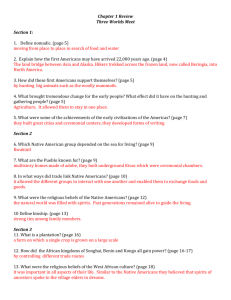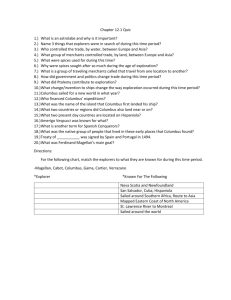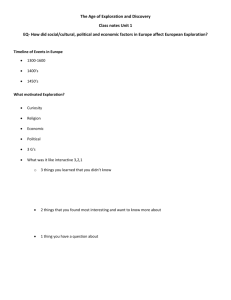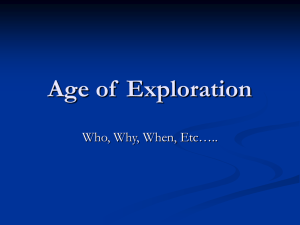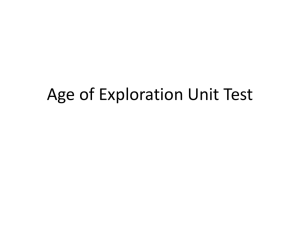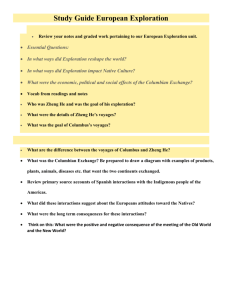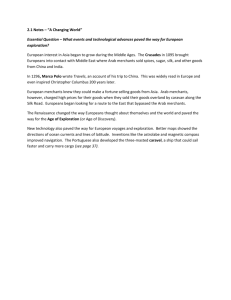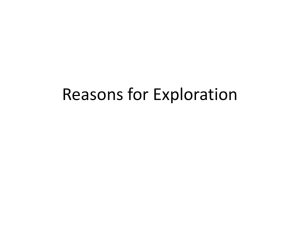The Paleo-Indians discovered America
advertisement
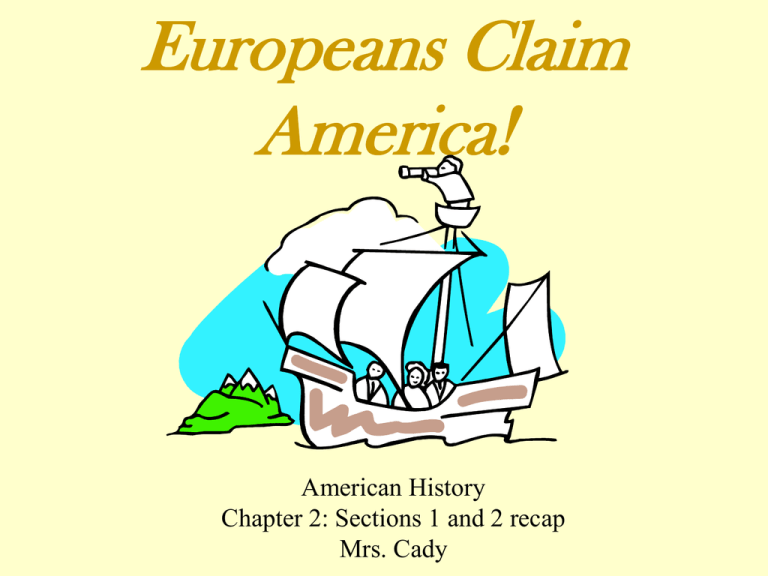
Europeans Claim America! American History Chapter 2: Sections 1 and 2 recap Mrs. Cady Wait a second…. Before we get started with this chapter we have to get something straight. Who were the first people to discover America? CORRECT! The Paleo-Indians discovered America (unknowingly) when they crossed over the Bering Land Bridge during the last ice age. THIS CONTINENT Ok, so if a nomadic tribe discovered America somewhere between 38,000 and 10,000 BC, who was next to step foot on this continent? CORRECT! It was the…… VIKINGS!! Vikings were skilled sailors, and they were the first Europeans to reach North America. Viking Voyages Vikings came from Scandinavia. Scandanavia?!? Where is that? Present-day Norway, Sweden, Finland, Denmark and Iceland The Vikings were skilled sailors and developed a new style of ship called a longship. They raided countries throughout Europe and developed large trading networks. In 1000 Leif Eriksson sailed from Norway to the North American coast after having been blown off course by a storm. They landed on and explored present-day Canada, Newfoundland and maybe even as far south as where? New England! They created a North American settlement, but attacks by Native Americans and the area’s isolation prompted the Vikings to return to Europe. Meanwhile, back in Europe…… Motivations for Exploration • Prince Henry the Navigator was responsible for advances that would make exploration more successful (though he never set out on a voyage himself) – He built an observatory. – He founded a school of navigation to teach better methods of sailing – He financed research by mapmakers and shipbuilders. – He paid for expeditions to explore western Africa. Motivations for Exploration • To find sea routes to develop additional trade routes with Asia • To spread Christianity – Christians wanted to convert more people to their faith. • To learn more about Asia and its culture. Why did people start to explore the world by sea? •God •Gold I have made my country proud! •Glory Technological Advances • Better instruments made it possible for sailors to travel the open seas. • The astrolabe enabled navigators to use the stars to chart location. Astrolabe MORE Technological Advances • The Portuguese began designing ships that were smaller, lighter, and easier to steer. • New ships called caravels used triangular sails that allowed ships to sail against the wind. Eventually, these Portuguese learn so much at Prince Henry’s school that they: Sailed around Africa and found a sea route to Asia. In 1488, some guy led an exploration from Portugal southward along African coast, discovering the southern tip of Africa, the Cape of Good Hope. Who was he? BARTOLOMEU DIAS In 1497, Vasco da Gama sailed around the Cape of Good Hope and landed in India, winning the European race for a sea route to Asia. VASCO DE GAMA Results of Exploration • As Portuguese sailors explored the west coast of Africa, they negotiated for gold, ivory, and slaves. QUESTION: What effect did slavery have on African communities? Portuguese sailors bargained with African rulers for gold, ivory and slaves, establishing the slave trade. The slave trade broke up families and increased warfare among kingdoms in Africa. Results of Exploration Slaves were sent to Europe and to islands in the Atlantic where they endured brutal living conditions. Other nations saw how wealthy and powerful Portugal was becoming, so they launched their own voyages of exploration. EUROPEANS REACH THE AMERICAS Christopher Columbus sailed across the Atlantic Ocean… • Christopher Columbus, a sailor from Genoa, Italy, heard stories of great wealth in Asia. • He persuaded King Ferdinand and Queen Isabella of Spain to pay for an expedition across the Atlantic. …and reached a continent that was previously unknown to him. • On August 3, 1492, Columbus set sail across the Atlantic with three ships. • On October 12, 1492, he reached the Americas. Hey, is that why October 12 is Columbus Day? YES! CHRISTOPHER COLUMUBS Columbus in the Americas Columbus and his crew landed in the Bahamas, on an island he named San Salvador. He called the native people Indians because he thought he was in the Indies. They were the tribe known as the Tiano. Columbus was interested in gold, not the culture of the native people. He made three more voyages to the Americas. The impact of Columbus’s voyages on the world was not realized until years after his death. Impact of Columbus – Changed view of the world • Interaction with Native Americans – Conflict between Spain and Portugal over land claims • Pope ordered Line of Demarcation divided the Atlantic Ocean Spain claimed all the land west of the line –Treaty of Tordesillas – moved line 800 miles further west So…why did the Pope create the Line of Demarcation? • Up to this time the two major powers exploring the world were Spain and Portugal. • These nations worried that their new territories would be taken by each other, or by others. • In order to protect their new empires, these nations looked to the Pope for help. • In 1493, the Pope drew a line on the globe cutting the new world in half. This line was known as the line of demarcation. • Any territory discovered on the east side of the line was to be controlled by Portugal, while any lands found on the west side of the line were to be ruled over by Spain. Line of Demarcation (moved 800 miles west after the Treaty of Tordesillas) Tor duh what?! Treaty of Tour- de- see- ahs After Columbus’s voyages, other explorers sailed to the Americas. Vespucci •America was named for Amerigo Vespucci, who sailed to South America in 1501. •The new world was named after him Balboa •Vasco Núñez de Balboa crossed Central America to discover the Pacific Ocean. Magellan •Ferdinand Magellan headed an expedition in 1519 that eventually circumnavigated, or sailed around, the world. FERDINAND MAGELLAN The Columbian Exchange •Explorers brought plants, animals, and diseases to the “New World” of the Americas and brought back plants and animals to the “Old World”—Europe, Asia, and Africa. •The Columbian Exchange is the name given to this transfer of plants, animals, and diseases between Europe and the Americas. •Explorers brought horses, cattle, pigs, and grains such as barley and wheat to the Americas. •Europeans took back such American plants as corn, tomatoes, tobacco, and cocoa. The Columbian Exchange
